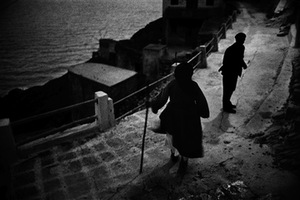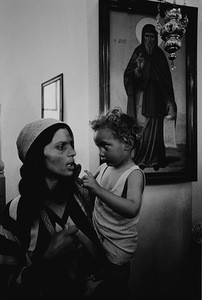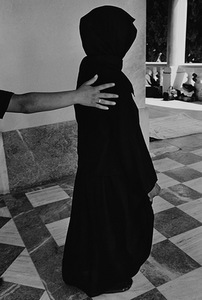Greek traditions in photography exhibition “Shadows of Silence” 3
The photography exhibition of the well-known Greek photographer John Demos is open at Kaunas Photography Gallery. In the exhibition, the author has captured people met during his trips in Greece, their surroundings and the mood. The man and the Greek landscape or architectural elements form an indivisible whole of the black-white photos and create a symbolic metaphysical Greek human portrait.
The photography exhibition of the well-known Greek photographer John Demos is open at Kaunas Photography Gallery. The exhibited works were created in 1975–1997.
John Demos graduated from Art History studies at the University of Chicago in the year 1966. He also obtained the Master’s degree in Painting and Photography at the same university. After his studies, he returned to Athens and began to work in the field of professional photography. In the year 1979, together with other photographers, he founded the Athens Photographic Centre.
Photography exhibitions of John Demos were presented in the famous galleries and museums in Netherlands, Greece, USA, Italy, UK, Spain, Paris, Portugal, Argentina, Bulgaria and elsewhere. The works of this artist have also been purchased by prominent museums and collectors.
John Demos, asked about the Greek photography school and its traditions, replied, “I don't know if there is a “Greek school”, nor can I say that it is one of the most interesting one in Europe today. There is a younger generation that could be promising. I admire what Papaioannou and Balafas did in a total vacuum in the previous generation. There is no specific focus on Greek photography today. There is a turn by a group away from the personal reportage of the past toward more “fine art” concerns. Yet, the younger may turn that back again in the days to come.”
In the exhibition, the author has captured people met during his trips in Greece, their surroundings and the mood. Mostly photos are religiously symbolical: a woman and a child are photographed next to the holy picture, an icon carried by a woman becomes part of the whole composition, the artist embodies the prayer concentration, the face expression and the figure. The man and the Greek landscape or architectural elements form an indivisible whole of the black-white photos and create a symbolic metaphysical Greek human portrait. It's like a visual diary of the Greek cultural customs and religious traditions. The characteristic details convey the author’s impressions, the character of the captured people and the mood of the crowd. In his black-white portraits, the photographer highlights the facial expression and sight. The works of J. Demos attract attention by their philosophical view: the author expresses his approach to the surroundings and the people, not only captures, but also summarizes and symbolizes what can be defined as part of the Greek identity and religious consciousness of Greeks. His photos stand out by the harmony of form and content, thoughtful, artistic and aesthetic composition, which is highlighted by the contrast of dark and light details. Sometimes the dialogue of the dark and light shadows is simple, sometimes complicated, but these artistic effects are always related to the overall aesthetics of the composition.
“During his tours to Greek cities and villages, J. Demos captures archaic rituals formed through many years and so reveals the dialogue between pagan and Christian traditions. Although the author focuses on the social aspect, the connections between anthropology, theology and philosophy remain equally important. J. Demos is not so interested in religion itself, but more in people’s faith and spirituality. (...) The works full of drama and contrasts create an almost theatrical illusion and its visual expression is full of links to religious paintings. People are like shadows, black or translucent figures – sometimes just silhouettes – narrating the strangest dramas. The artist's style subtly plays between representations and metaphors. The phenomenological and metaphysical aspects, aesthetics, harmony of form and content are essential in his works. (From the annotation of J. Demos’ photography exhibition “Shadows of the Silence”).
Road, black coat, mountain, temple, rock and similar symbols are met in many photographs of J. Demos. He shows the importance of the meaning of faith and invites visitors to observe the vibrant, emotional and psychological images, captured in a variety of forms. The world of signs and symbols draws in the whole of faith rituals.
John Demos agreed to answer a few questions.
When did you became interested in art photography and started to create? What was your first inspiration?
I came to photography because of my father’s Leica M 3, the first photo book that I saw was “The World of Henri-Cartier Bresson”, the summer trip I took back to Greece while studying art history at the University of Chicago, the exhibits I saw at the Art Institute, the films of Bergman...
Is the theme of faith the most important in your photos?
Photography, I believe, is a minor art; not a major opening to the soul such as music, the supreme art for me. Yet even in its minor role it can open a small window into human existence. Within those dimensions it is fascinating, if it can provide us with an insight into “other realities” of our world.
The subject or theme of a project cannot be an end, any more than art for art's sake can be revealing. I did not choose to work on Christianity. I found myself gravitating to the periphery of religious events because I saw that people and situations were bigger than themselves.
The plethora of emotions, the impulse to believe, the sincerity of people, the complexity of symbols, were all energized at certain moments in such surroundings.
What I feel is hard to explain, and there is really no need. The photographs are there to speak for me. If I am successful, a complex chord is there in the totality of the images.
You are working hard in a few art spheres: as a teacher, photographer and publisher. Do these spheres complement each other?
I have been a teacher for 17 years, creating courses in art, art history, humanities, philosophy, and photography. I started as a painter and would love to pick up drawing again, which I find very satisfying. Do I feel as an artist, a photographer, a teacher? When so many photographers want to play as fine artists, and so many artists are using photography, the lines are blurred. I like to separate them. I like the intrinsic nature of the lens and the silver surface, and have spent most of my creative time in those pursuits. Yet I have no problem in these facets coexisting in me, and in the various phases I have gone through in my life. Together they define me more fully.
What is the exclusivity of the photo series about faith?
To understand the drama of belief, you must go close – quietly, and with respect. I was there with the people trying to understand my own feelings through them. That is the beauty of such involvement. They were not opening themselves to me but to something larger. I was there to partake in their agony.
The aesthetics are secondary, they flow from within you automatically. And if there is unison, there is no ethical issue. I was believing, agonizing, and questioning my own faith with them. There were no miracles.











